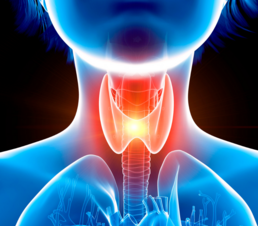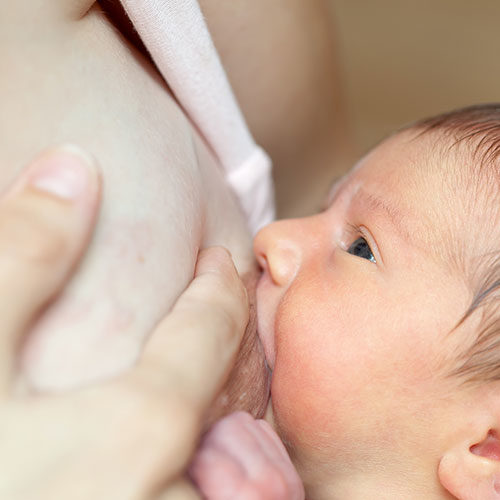I am suffering from Thyroid can I breastfeed my baby? Will I be able to make enough milk?
Thyroid Gland plays an important part in lactation as it is connected with the regulation of prolactin (the hormone responsible for milk production) and oxytocin (the hormone responsible for ejecting the milk flow).
Types of Thyroid Dysfunction:
1) Hypothyroidism (Underactive Thyroid)-
This condition is developed when the TSH levels are high and the thyroid gland produces insufficient thyroid hormones. The symptoms include weight gain, intolerance to cold, depression, fatigue, hair loss, dry skin, heavy and prolonged menstrual flow etc. Most commonly, this is a result of Hashimoto’s disease which is an autoimmune disease wherein the immune system attacks the thyroid gland causing underproduction of thyroid hormones.
A breastfeeding mother with hypothyroidism is likely to face low milk supply
2) Hyperthyroidism (Overactive Thyroid)-
This condition is developed when the TSH levels are low and the thyroid gland produces excessive amounts of thyroid hormones. The symptoms include weight loss, intolerance to heat, anxiety, fatigue, palpitations, increased pulse rate, light to no menstrual flow etc. Most commonly, this is a result of Grave’s disease wherein the antibodies attack the thyroid gland causing it to grow and over-produce the thyroid hormones.
A breastfeeding mother with hyperthyroidism is likely to face problems with the let-down reflex. Some women with hyperthyroidism have reported oversupply.
3) Postpartum Thyroiditis (PPT)
During pregnancy, the immune system of the mother is naturally suppressed to ensure that the developing foetus is not perceived as a threat and the immune system doesn’t attack it.
After the birth of the baby, the immune system of the mother has heightened once again. This switch sometimes can cause ‘postpartum thyroiditis’. It is observed in 5%-7% of all pregnancies and maternal smoking and type-1 diabetes increase the risk of postpartum thyroiditis threefold.
Postpartum thyroiditis can manifest itself as hypothyroidism alone, hyperthyroidism alone or in many cases, as a combination of both wherein it typically starts with hyperthyroidism for a few weeks and then transitions into hypothyroidism for several months.
Most women with PPT recover fully. However, a small percentage can retain hypothyroidism.
Some breastfeeding women having PPT report supply issues and many others don’t face any such issue
Impact on Breastfeeding
- A breastfeeding mother with hypothyroidism is likely to face a low milk supply.
- A breastfeeding mother with hyperthyroidism is likely to face problems with the let-down reflex. Some women with hyperthyroidism have reported oversupply.
- Some breastfeeding women having PPT report supply issues and many others don’t face any such issue.
Is it safe to Breastfeed with Thyroid?
Research* suggests that It is absolutely safe to breastfeed for a woman who is suffering from any of the three forms of thyroid dysfunction mentioned above. It is safe even if the mother is not taking medication to control or maintain her thyroid levels. There is no risk to the baby. Even in the autoimmune types of thyroid disease, the antibodies are too large to pass into the breast milk. In hypothyroid, even a mother with extremely high levels of TSH passes very low levels of TSH through her milk which is not a cause of paediatric concern. And in hyperthyroid, even a mother with very high levels of T4 and T3 passes on exceedingly low levels of these hormones into the breast milk. If the mother is on medication, there are always breastfeeding-friendly alternatives available.
[*Research – Lawrence & Lawrence 2011. Hale, 2017]Tips to manage Breastfeeding with Thyroid :
- Many women have reported that their thyroid levels change with pregnancy and childbirth. So, frequent testing and follow-ups are recommended.
- Milk Removal (let down reflex) should be addressed on priority. Massaging and breast compression while nursing can help. Sometimes oxytocin/Pitocin nasal spray can facilitate milk ejection.
- Once milk removal is sorted, supply can be worked on. Galactagogues are recommended as supportive treatment.
- It’s important to keep a keen eye on baby’s urine/stool output and weight gain to ensure that the baby is getting enough.
- It is important to have the medication as prescribed and it might make more sense to keep the thyroid levels in the upper spectrum of the normal range.
How does it help?
- Babies who are artificially fed are at risk of developing autoimmune thyroid disease. Therefore, breastfeeding surely lowers that risk.
- Breastfeeding may also provide protection against the thyroid cancer in the mother.
References :
https://www.llli.org/breastfeeding-info/breastfeeding-and-thyroidism/
https://www.breastfeeding.asn.au/bfinfo/breastfeeding-and-thyroid-disease
https://kellymom.com/health/mom-health/thyroid-faq/

Wish to speak with a member of our team who is a certified lactation professional and also an experienced breastfeeding mother, click on this link.
Medical Advice Disclaimer
THIS WEBSITE DOES NOT PROVIDE MEDICAL ADVICE.
The information, including but not limited to, text, graphics, images and other material contained on this website are for informational purposes only. No material on this site is intended to be a substitute for professional medical advice, diagnosis or treatment. Always seek the advice of your physician or other qualified health care provider with any questions you may have regarding a medical condition or treatment before undertaking a new health care regimen, and never disregard professional medical advice or delay in seeking it because of something you have read on this website.
Disclaimer
We understand and acknowledge that parents and babies can be of various genders on a spectrum of LGBTQI+. Families come in diverse flavours. However, in our articles, for the sake of simplicity and convenience, we will be referring to the breastfeeding parent as the mother and using the female pronouns- ‘she’ and ‘her’ for babies. Babies can be nourished and nurtured in different ways and while we have used the terms breastfeeding and nursing, we recognize that parents can opt to chest feed or finger feed.
We don’t have conflicts of interest and declare, and we are compliant with the WHO code of marketing of breastmilk substitutes and the IMS act.
In case you find any information on this website that needs to be updated, please write to us at info@bsim.org.in






